Have you successfully grown your first cannabis plant and are now anxiously awaiting harvest time? This beginner’s guide will help you know when to harvest, how to harvest, and what to do with your harvest once it’s ready.
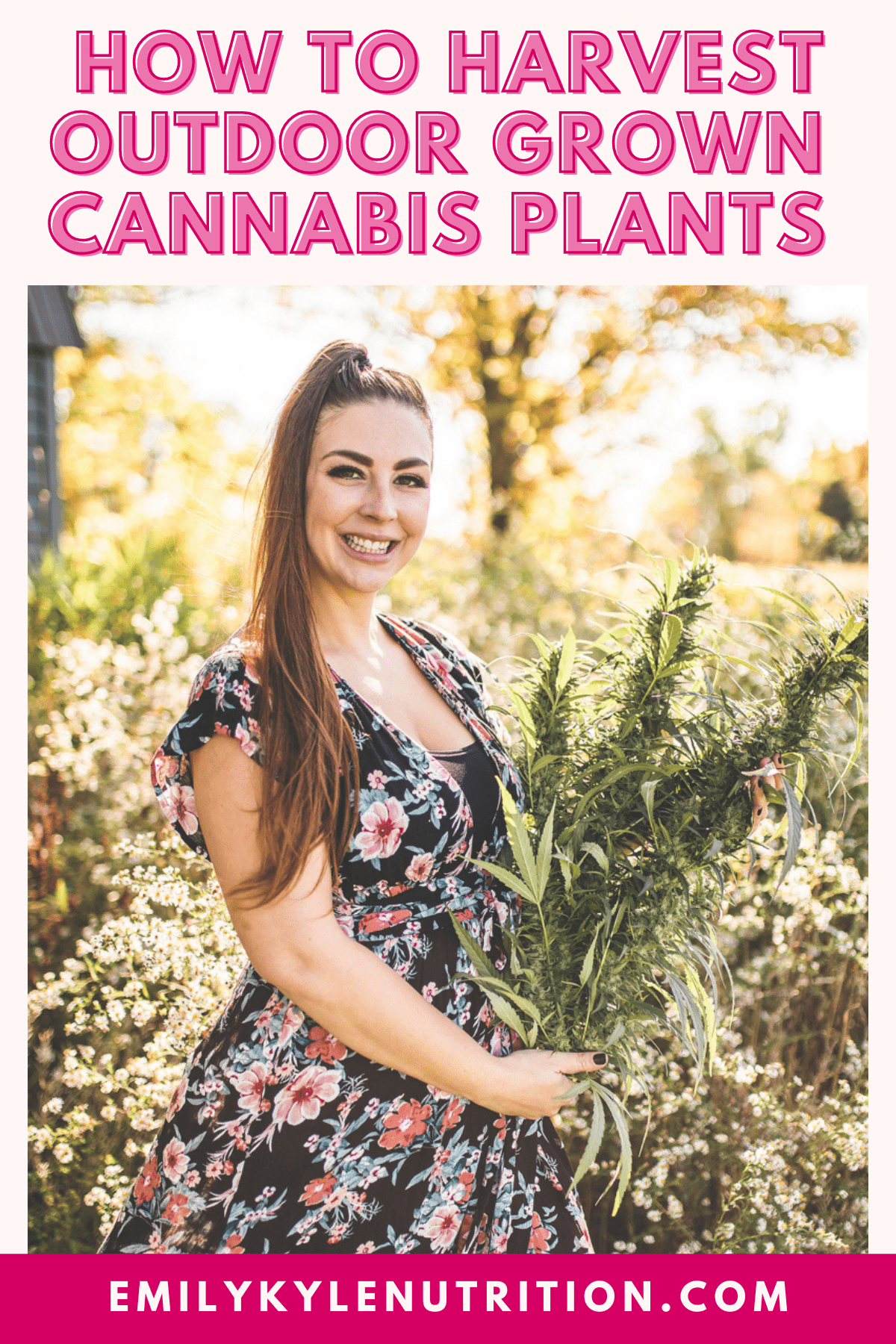
Table of Contents
- Features
- Why You Will Love This Guide
- When To Harvest Cannabis Plants
- Gather Your Materials
- Prepare Your Drying Space
- Remove the Fan Leaves
- Cut Down the Plant or By Branch
- Wash The Plant
- Hang to Dry
- Trim Additional Leaves
- Cut Down to Buds
- Jar to Cure
- How to Harvest Outdoor Cannabis Plants Recipe
- More Guides You Will Love
Features
- First steps to knowing when to harvest marijuana plants
- Tips, tricks, and materials needed for the harvest
- How to dry and cure your harvest for long-term storage
Why You Will Love This Guide
There is nothing more exciting than the month every outdoor grower has been waiting for October, Croptober, harvest season!
Many first-year cannabis growers in my Well With Cannabis Community report it is equally exciting and nerve-wracking as time approaches.
And I totally understand; you don’t want to do anything wrong and waste all your hard work!
From knowing when to pick the right time to harvest to knowing what to do with it once you’ve cut it down, this guide will walk you through the best way to harvest a cannabis plant.
Remember, the ultimate goal here is to preserve the harvest, potency, and THC levels while reducing the opportunity for mold to grow.
When To Harvest Cannabis Plants
The first, hardest, and most important part of the harvest process is knowing when to do so.
If you are growing photoperiod cannabis plants here in the Northern hemisphere, October is generally the perfect time to begin harvest.
Ultimately, there is a lot of variation of when a plant can be considered “the best time,” depending on your unique situation and personal preference.
The first step is to ensure you are starting with female cannabis plants that have made it to the flowering stage.
To ensure you only grow female cannabis plants, you must start with feminized seeds or clones.
The plant will produce many large fan leaves during the growing process, from the seedling to the vegetative stage.
As the plant transitions into the flowering stage, generous amounts of trichomes begin to form on the flower buds and sugar leaves of mature plants.
This resin production on the mature cannabis plant produces the medicine we want, cannabinoids like THC and CBD.
Visual Changes
During this flowering phase, you will notice white pistils that look like long white hairs growing on the cannabis flowers.
As time nears, these pistils will undergo visual changes that will help you know when to harvest.
The naked eye can see the pistils and their associated color change.
As the plant gets closer to being ready, the white hairs will begin to turn orange or appear as brown pistils.
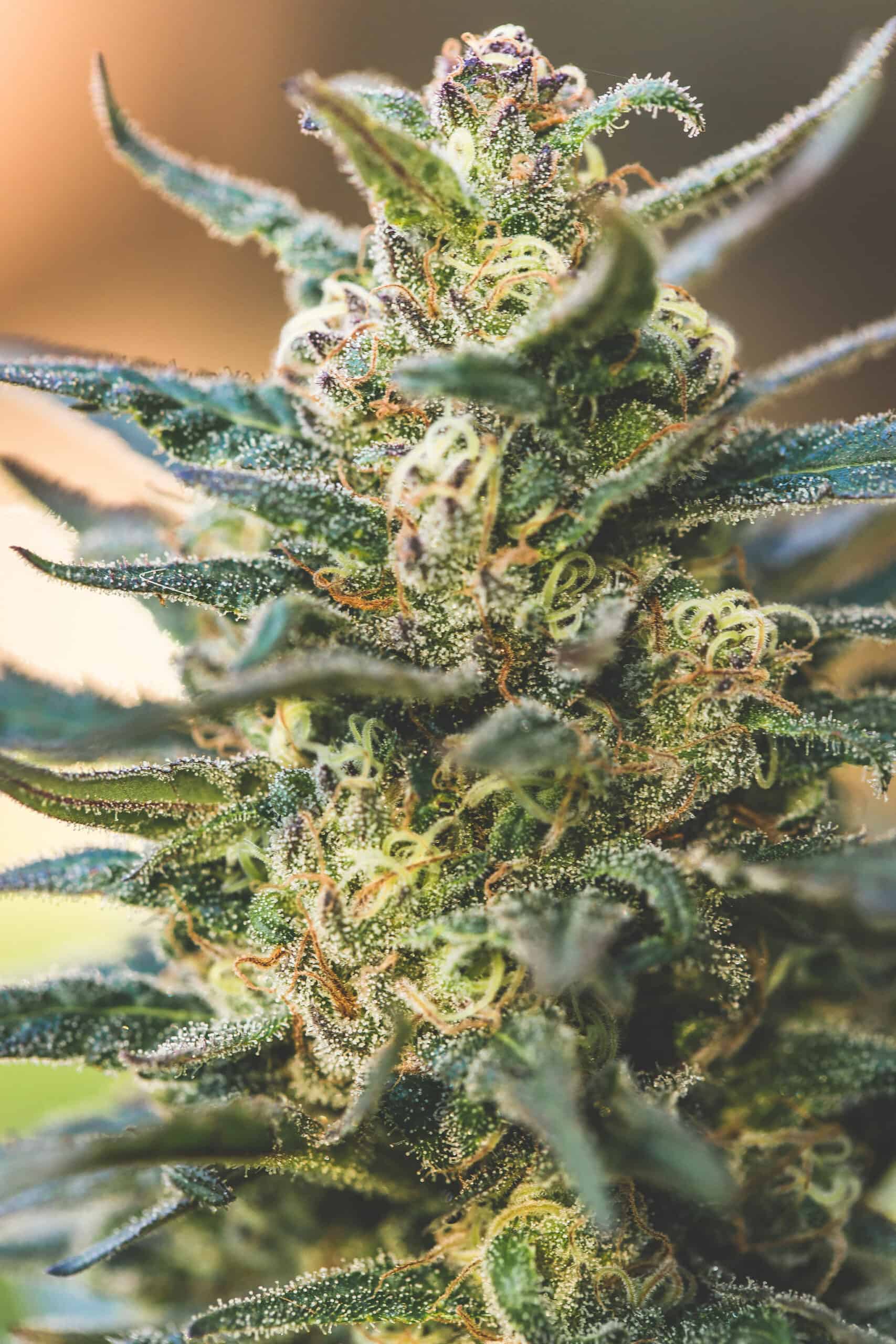
The Trichome Method
Along with observing the visual changes in the pistils, experienced growers use the trichome method to pick the ideal harvest time.
It is a good idea to get a magnifying glass or jeweler’s loupe to get a closer look, as the naked eye does not easily see these tiny resin glands.
Early in the season, the trichomes will appear completely clear during the flowering stage.
As the plant matures and gets closer to the proper time for harvest, the trichome color will begin to change.
The change will transition from clear trichomes to cloudy trichomes to amber trichomes.
As a general rule of thumb, the closer the trichomes get to an amber color, the more likely they will have a sedative, sleepy effect.
Knowing when to harvest the plants will be up to you and your preferred experience.
There’s No ‘Perfect’ Time
Keep in mind that different cannabis strains may be ready at different times.
Different strains from Indica plants or Sativa plants will have unique growing requirements.
If this is your first time growing, keep a close eye on any mold or bud rot developing in the growing plant.
Take a close look at the buds every few days during the ideal time for the harvest to ensure everything still looks good.
Remember, cannabis cultivation is both an art and a science; it may take years to get to what you consider a successful harvest.
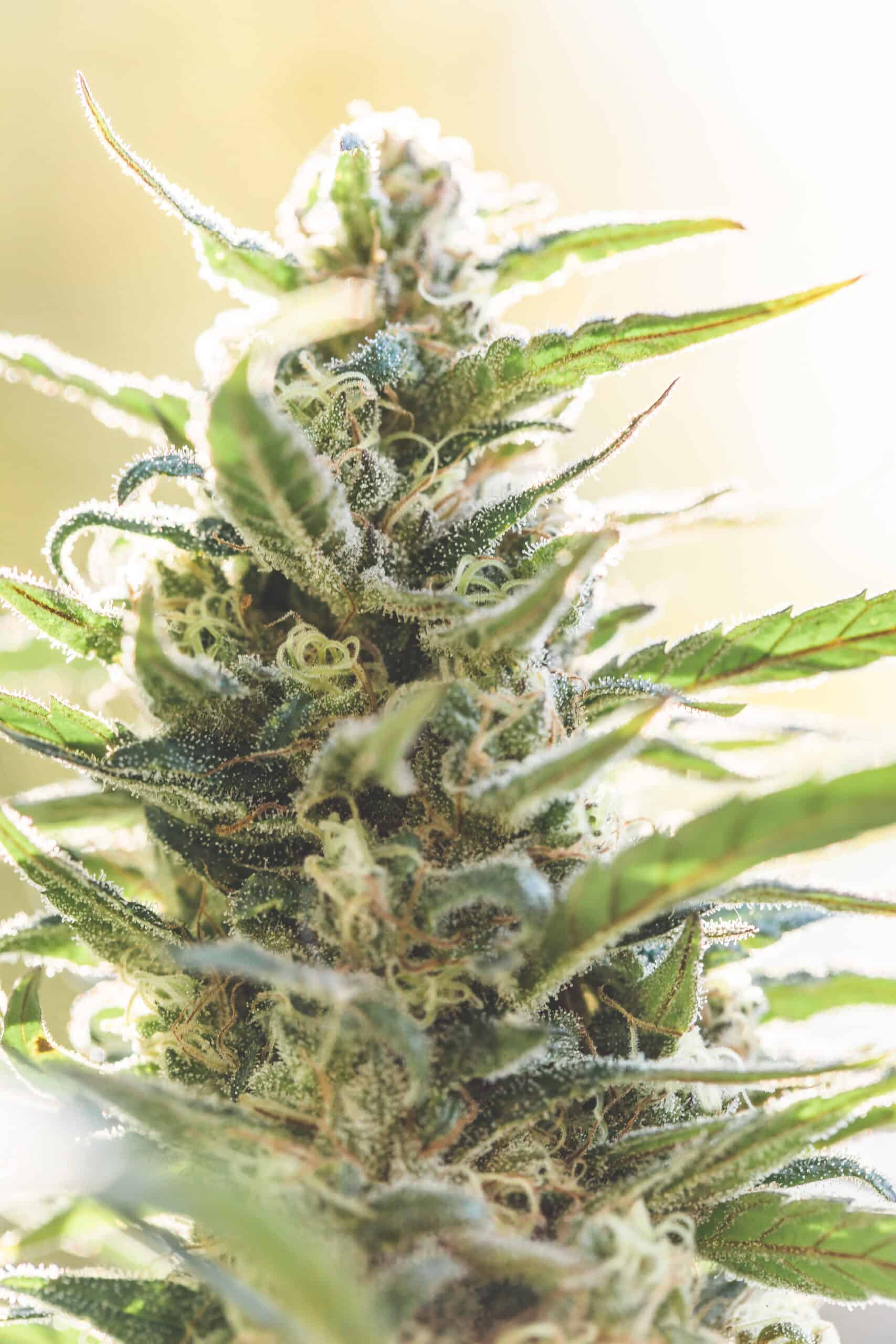
Gather Your Materials
Once you’re confident you know it’s the right time to harvest, the next step is to take some time and gather your materials before getting started.
These materials are not required but can help set you up for a successful experience.
- Gloves, optional
- Jeweler’s loupe
- Digital scale
- Boveda packs
- Gardening scissors
- Rubbing alcohol or high-proof grain alcohol
- Compost bucket
- Glass jars, like Mason Jars
- Container to collect trim for edibles, oven-safe is ideal
- Drying rack, optional but helpful
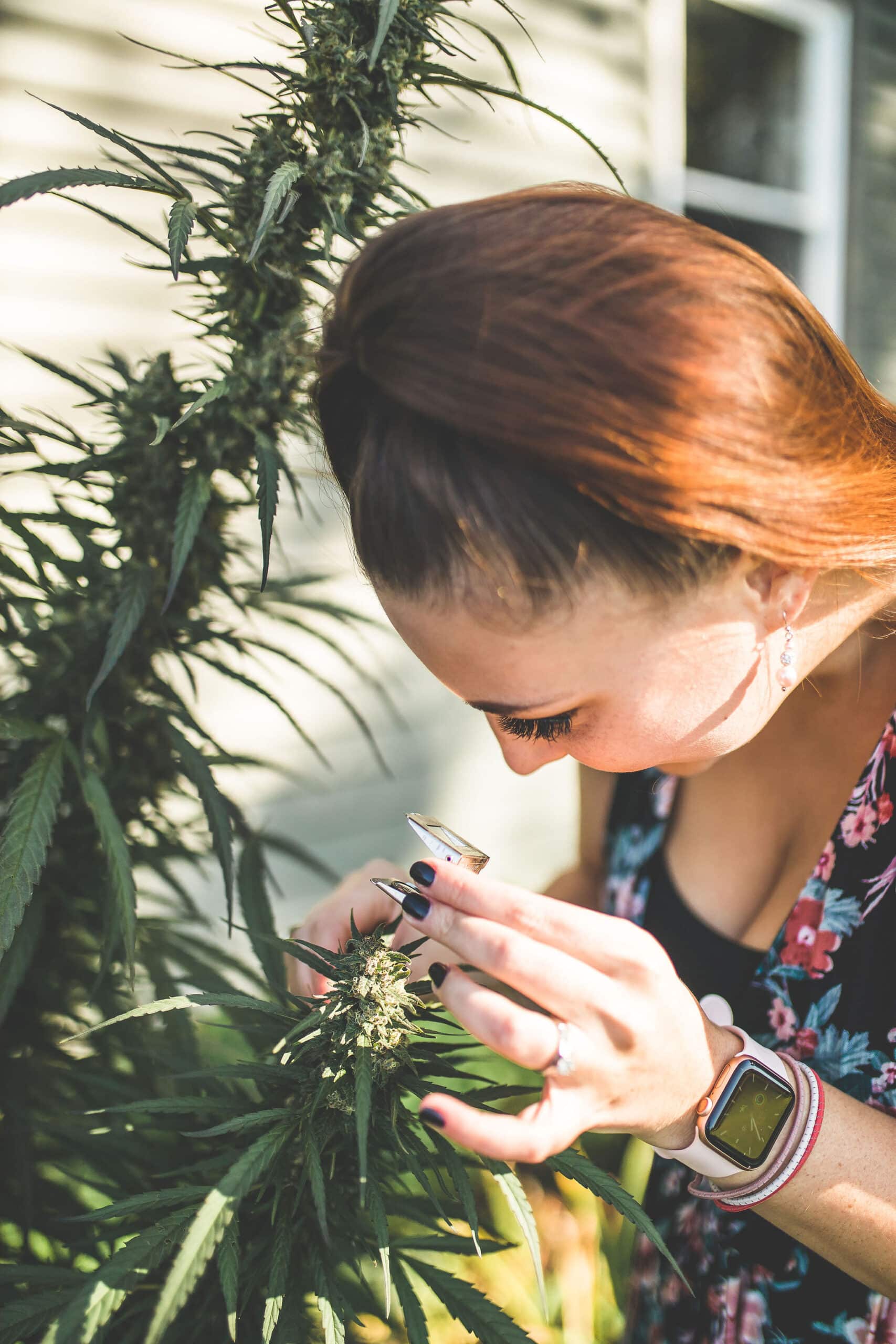
Prepare Your Drying Space
After the plant is cut down, it will need to be dried.
The drying process helps to remove any moisture that could cause your final product to mold or develop mildew.
For best results, preparing your drying space before getting started is important.
There’s nothing worse than cutting down your weed plants only to find yourself unprepared for the next step.
Your drying space doesn’t need to be fancy initially; you can always upgrade and expand over time.
Ideally, in your drying room, like your grow room, you want to be able to control the following:
- Airflow – good airflow is essential
- Humidity – how much humidity is in the room
- Temperature – you don’t want it too hot or too cold
- Light – a dark place is ideal
Then, you will need to consider how you will hang the plants.
You can use a tension line across the room to hang the plants or invest in these convenient drying racks.

Remove the Fan Leaves
Now that you know it’s the right time to harvest and have gathered your materials and prepared your drying space, it’s time to start!
The first step is removing the fan leaves or the large ones that protrude from the plant’s branches.
It is important to remember the difference between fan leaves and sugar leaves at this time. For this step, we are just removing the fan leaves.
There are many different ways to do this. I prefer to trim these fan leaves while the plant is still growing in the ground.
I typically start a few days before I want to harvest and enjoy my time spent out in the garden. Of course, you can do this inside if you desire.
Keep in mind these leaves contain very few trichomes and therefore are not that potent.
They also contain a lot of chlorophyll, which means they will taste very strong and transfer a lot of green color to your final product.
You can save them for edibles, but know that the benefits will be more nutritional than medicinal.

Cut Down the Plant or By Branch
Once you have removed all the fan leaves from the plant, it is time to cut them down and bring them into your drying space.
Depending on your plant size, you can cut it down branch by branch, starting with the main stem, or cut the entire plant down at once.
Keep in mind the space available for drying and what would work best for your set-up.
Next, decide if you want to proceed with wet trimming or dry trimming the additional leaves.
If you cut down the whole plant at once, be sure to save the root ball to make a cannabis root tincture.
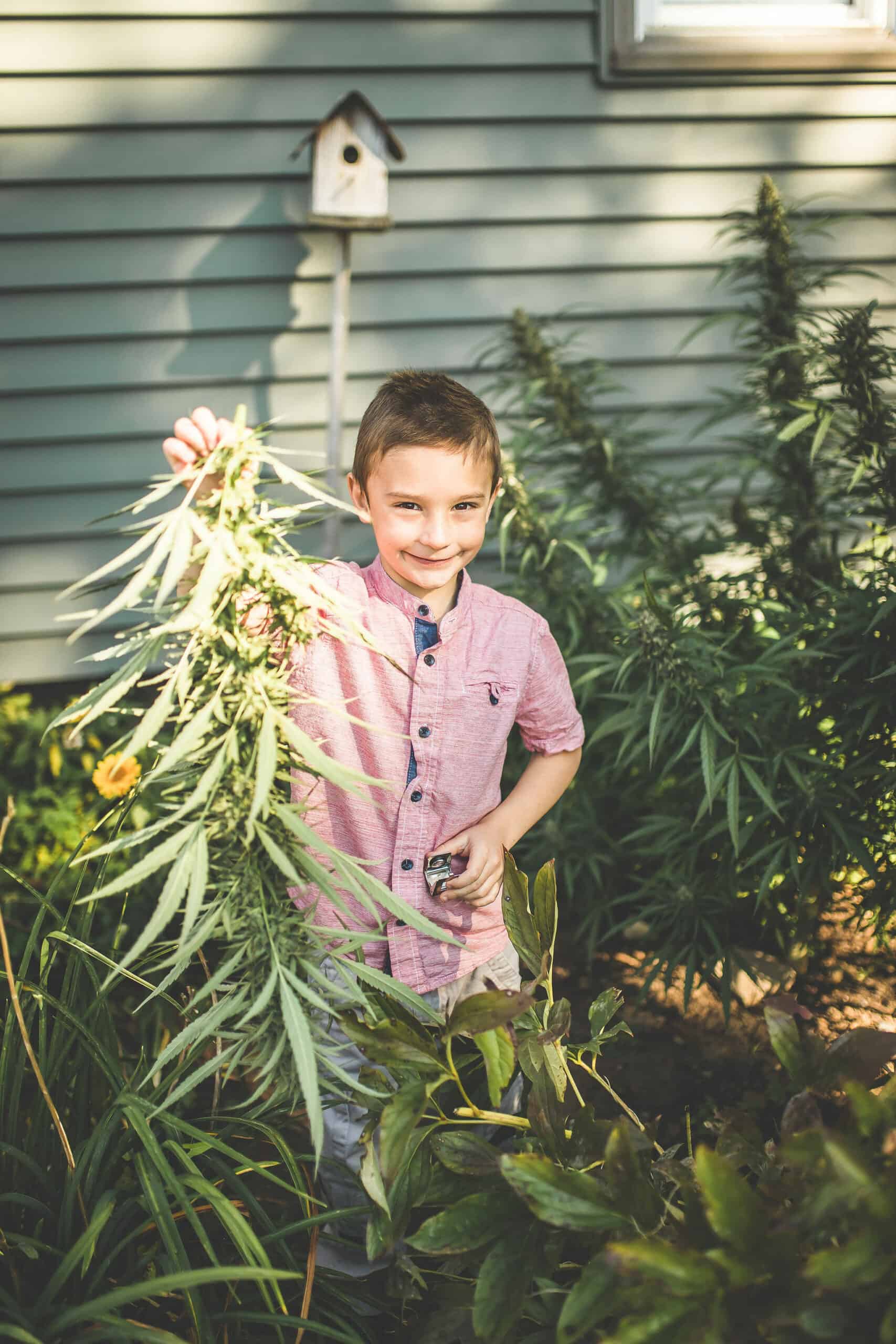
Wash The Plant
This step is optional, but many outdoor cannabis growers prefer to wash the plant before drying.
Outdoor plants can collect unwanted environmental factors like bugs or debris.
A gentle wash in clean water will not harm the plant or its potency, but it can help to remove any unwanted material.
If you take this step, be aware that any extra moisture can cause mold formation, so it is very important to have a good handle on your temperature and humidity settings in your drying room.
View my complete guide to washing your cannabis here (coming soon)!
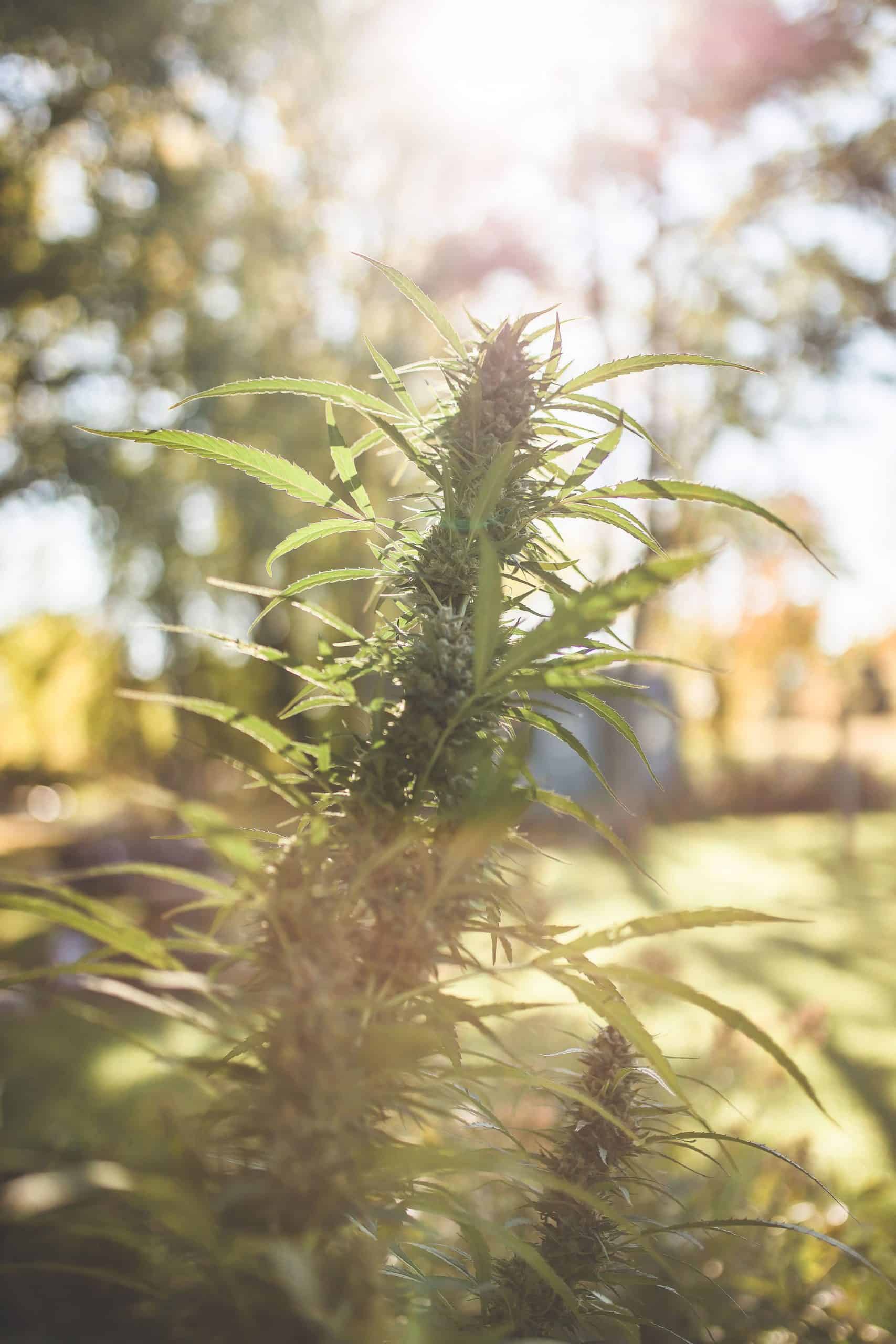
Hang to Dry
After deciding whether you want wet or dry trim, it’s time to hang the plants to dry.
In your drying room, hang the plants or branches upside down from your line or place them on a drying rack.
In most cases, the buds on large branches are sturdy enough to hold up the branch and rest on the line.
If you have trouble with this or need more space, use coat hangers and clips to clip the branches to the hanger or set up a drying rack.
How long you need to dry the flower will depend on your plant’s moisture level and the drying room conditions.
For my harvest, we aim for the following
- Days 1-3: Temperature: 64-68°F, Humidity: 50%
- Day 4 -7: Temperature: 64-68°F, Humidity: 50% » Increase the humidity by 5% every day up to 70% humidity
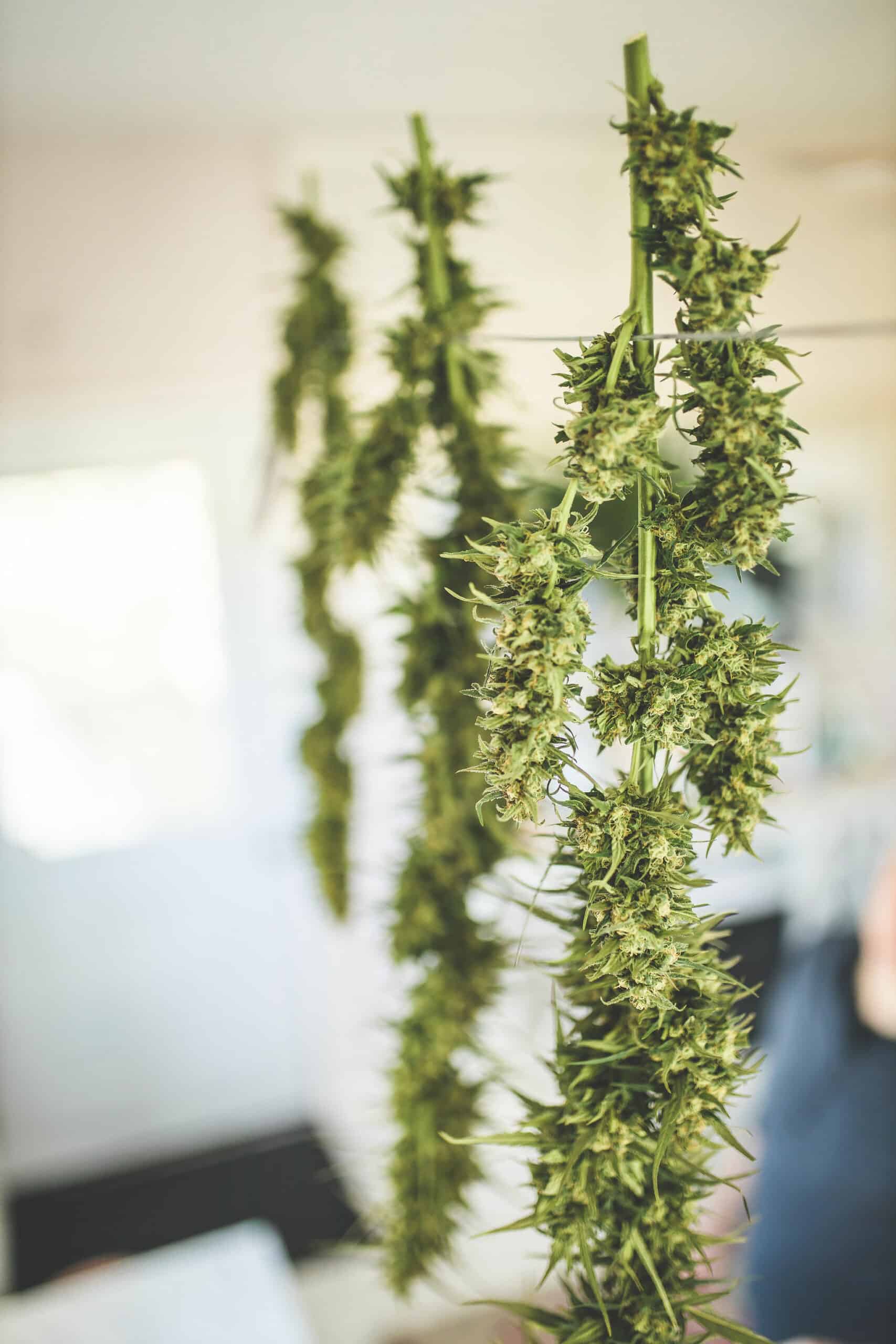
Trim Additional Leaves
You will often want to trim more leaves from the plant than just the fan leaves.
Sugar leaves are small leaves that grow near the cannabis buds.
They are not ideal for smoking, but they contain trichomes, which is worth saving for edibles and topicals.
You will most likely want to rim these additional leaves from the buds. There are two ways to remove the excess leaves: wet trimming or dry trimming.
Wet trimming happens before the drying process, and all of the small leaves around the buds are cut off and collected in a separate container to be dried.
Dry trimming happens after the drying process. Still, the small leaves around the buds are cut off and collected.

Cut Down to Buds
Once the buds and brings are completely dry, they can come out of the drying room.
If you are dry trimming this can be done now.
Once the buds are trimmed to your specifications, you can cut them one by one off the branches.
If you are interested in knowing the total weight of your harvest, now would be a good time to weigh your dried product.

Jar to Cure
The final step is to cure the flower, which is relatively easy.
A good cure can help enhance the plant’s overall experience by preserving the cannabinoids and terpene profile.
To get started, gather your mason jars and place a Boveda pack in each one.
This pack will help control the humidity and prevent mold.
Then, place your freshly dried and cut buds into the mason jar. Secure the lid. This begins the curing process.
During the curing stage, you will leave the flower buds in the glass mason jars with the lids on.
You will then remove the lids for a specific time each day, a technique known as “burping.”
For my harvest, we aim for the following
- Temperature: 68-69°F
- Humidity: 64% » 56-70% humidity is ideal. Above 70% is too wet, and the bud should be removed from the jar and dried further.
- Action: Burp daily by removing the lid from the jar and allowing the contents of the jar to breathe. After 20 minutes, reattach the lid.
- Frequency: Repeat the burping process every day for 4 weeks.
- Storage: The jars are ready for long-term storage after the 4-week curing process. Aim for 59-63% humidity.
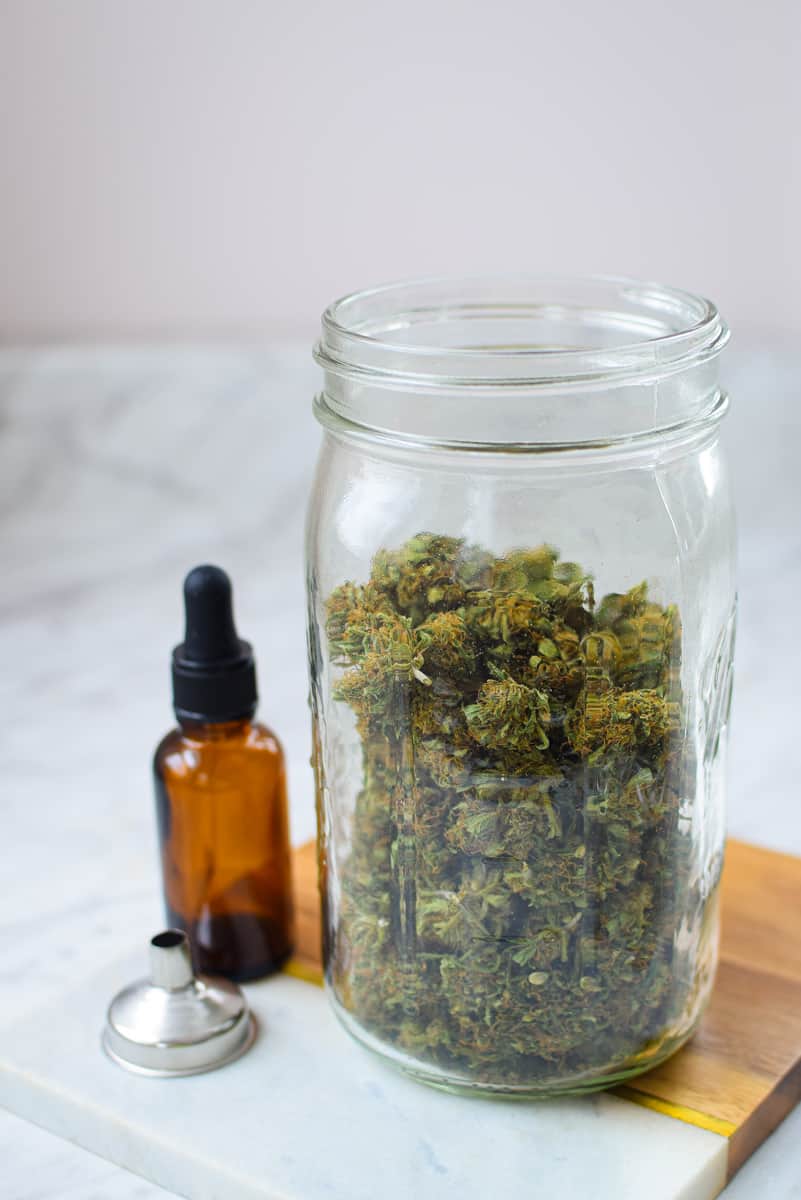
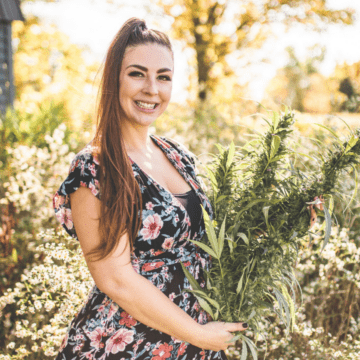
How to Harvest Outdoor Cannabis Plants
Watch The Video
Equipment
- Gloves
- Compost bucket
Instructions
- The first, hardest, and most important part of the harvest process is knowing when to do so. Use the tips and tricks listed above for assessing the visual appearance of both the pistilsl and the trichomes to determine your harvest date.
- The next step is to gather your materials. While you don't need anything fancy or special, it can be helpful to have the materials listed in the equiptmen section above.
- For best results, preparing your drying space before getting started is important. Select an area where you can control the airflow, temperature, humidity, and light.
- It is important to remember the difference between fan leaves and sugar leaves at this time. For this step, we are just removing the fan leaves.
- Once you have removed all the fan leaves from the plant, it is time to cut them down and bring them into your drying space. Depending on your plant size, you can cut it down branch by branch, starting with the main stem, or cut the entire plant down at once.
- This step is optional, but many outdoor cannabis growers prefer to wash the plant before drying. If you take this step, be aware that any extra moisture can cause mold formation, so it is very important to have a good handle on your temperature and humidity settings in your drying room.
- fter deciding whether you want wet or dry trim, it's time to hang the plants to dry. In your drying room, hang the plants or branches upside down from your line or place them on a drying rack.
- Once the buds and brings are completely dry, they can come out of the drying room. If you are dry trimming this can be done now. Once the buds are trimmed to your specifications, you can cut them one by one off the branches.
- Place your freshly dried and cut buds into a mason jar with a Boveda humidity pack. Secure the lid. This begins the curing process. During the curing stage, you will leave the flower buds in the glass mason jars with the lids on. You will then remove the lids for a specific time each day, a technique known as "burping."
- After 1-4 weeks of cure, you cannabis is ready for long term storage in an air-tight container like a mason jar. From here it is ready to smoke or to be decarbed to make edibles and topicals.

Everything you wish someone taught you…
The Cannabis Compass Online Course will show you how to use, apply, and dose cannabis safely and effectively so that you can begin to manage your anxiety, pain, and inflammation the natural way from the comfort of your own home. Learn more below.
More Guides You Will Love
Articles & How-To Guides
Male vs. Female Cannabis Plants » Why It’s Important
Articles & How-To Guides
How to Use Cannabis Fan Leaves in Edibles
Articles & How-To Guides
What You Need To Know About Cannabis Trichomes
Articles & How-To Guides

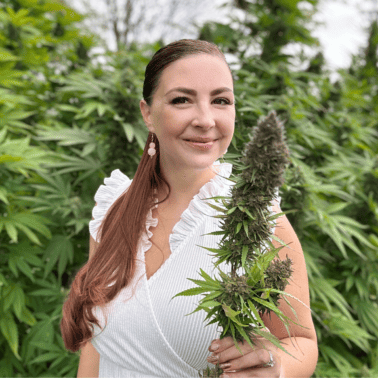
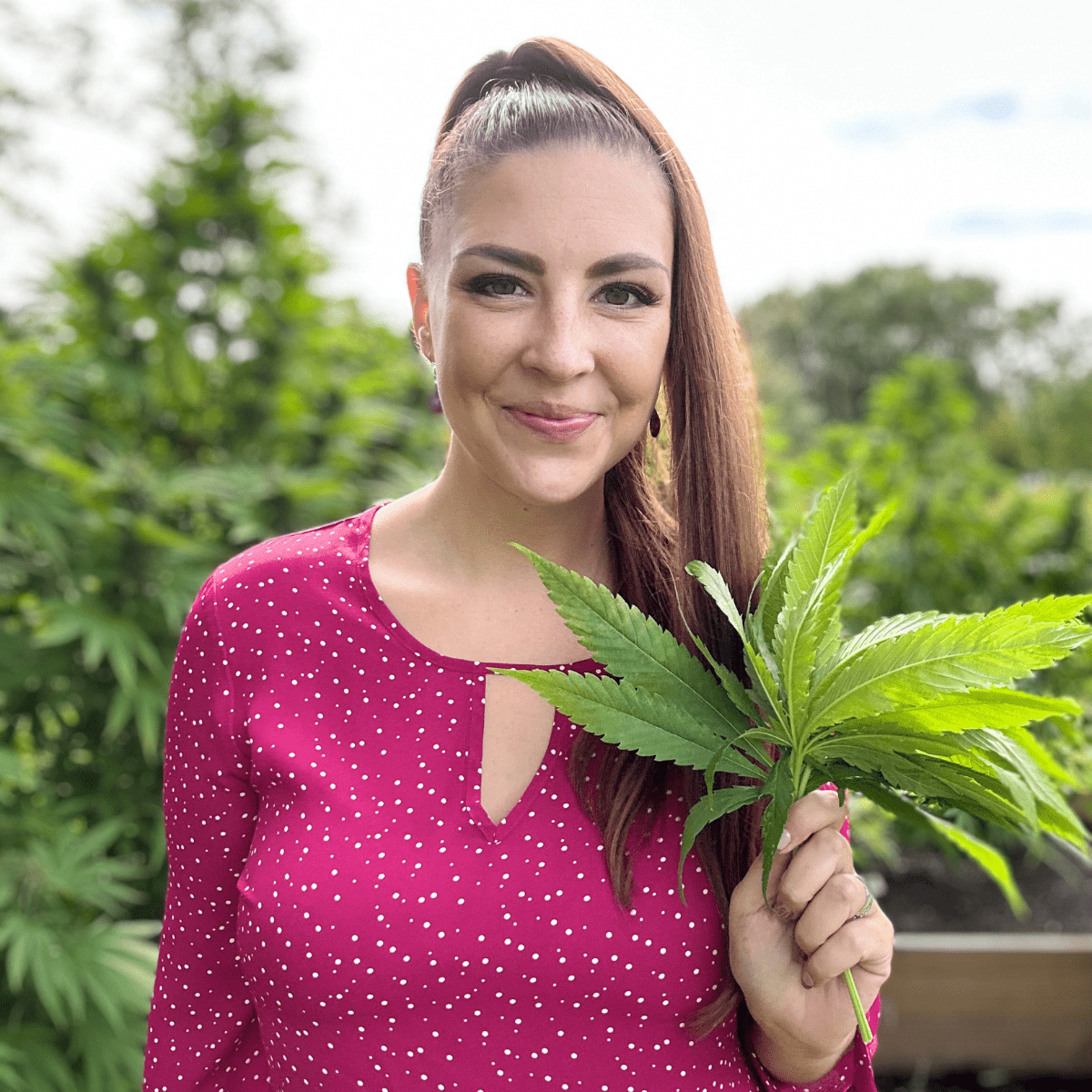
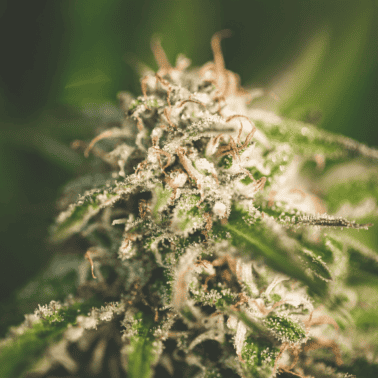










Hi Kat. I am so so sorry to hear of your diagnosis. Without question, I recommend the Rick Simpson Protocol, which involves dosing with RSO/FECO. The dosage plan recommended by Rick Simpson starts with very small amounts, slowly increasing over time. FECO/RSO is known for its healing and relief benefits for cancer patients. Please feel free to reach out with any further guidance during this journey of yours. Sending you all the healing vibes we can!
Hi Louisa. Self-sufficiency with cannabis can truly be life-changing and empowering, especially for those who rely on it for medicinal purposes. Thank you for your feedback!
Hi Nancy. Thank you for your feedback on the video! We’re glad you found it informative and that it changed your approach to cutting off sugar leaves before drying. That’s a great suggestion about labeling the jars with the product name and keeping track of all the details from harvest. It’s unfortunate to hear about the caterpillar issue in your 2022 crop, but it’s great to know that the organic spray was effective in resolving the problem.
We appreciate your comment and hope you continue to find our content helpful. Happy gardening!
Hi Ylan. Thank you for your kind words. It is crucial that buds are dry before beginning the curing process to prevent mold growth. Here are some signs to look for:
1. Snap Test: Gently bend a smaller stem of the bud. If it breaks with a distinct snapping sound, it indicates that the buds are dry enough for curing.
2. Bud Texture: The exterior of the bud should feel dry to the touch, with no moist or spongy areas.
3. Buds Separating from Stems: If some buds have already separated from the stem, it indicates that they may be dry enough for curing. However, it is essential to ensure that ALL buds have reached the optimal dryness.
If you have concerns about mold due to mold illness, consider using a dehumidifier or controlling humidity levels in the drying area to minimize the risk of mold formation. I hope this helps!
Hi Demetria! Thank you for sharing your thoughts! It’s completely normal to feel overwhelmed by the process of growing. Great things take time and effort. Keep learning about the growing process and you’ll be ready to to DIY in no time!
I love getting ur emails and reading and learning.I don’t grow but know ppl who do. My edible tolerance is stupid high because of my medical issues and I refuse pain meds being in recovery. Once I get some extra money I will be placing an order. It’s progress not perfection. Thank you Emily. 😊
Michelle Lucas 🙏
Oh no, Robert, spider mites can be such a hassle for outdoor grows! I totally understand why you made the switch to indoor growing. It’s great that your Vivosun 4×4 tent, along with the LED light and ventilation, have been bug-free so far. The “nature conservancy” across the river might indeed be the source of those pesky insects. Happy growing in your new indoor setup!
Hi Dinger. When it comes to storing trim for later use, here are some tips:
– Store in an airtight container to maintain freshness and prevent drying.
– If using trim within a few days, store it in the fridge.
– For longer storage, place it in a freezer for several months.
– When ready to use frozen trim, transfer it to the fridge and let it thaw overnight for optimal flavor and texture.
I hope this helps! Happy trimming!
Hi Ellen. Thank you so much for your kind words and feedback on the guide! Making it detailed, easy to follow, and user-friendly is our goal. Your appreciation for our knowledge and expertise means a lot. Happy harvesting!
Hi Emily ! Watched the video on how to harvest and found it to be very helpful. My hubby and I met you at the local library last year and joined your group shortly after . Haven’t had as much time as would like to read info or watch all your videos but going to make a conscious effort to as they are very informative . Know you had recipes you posted last year are they still on website to refer to ? Again thank you for your advice . You did great on the video love how down to earth and personable you are.